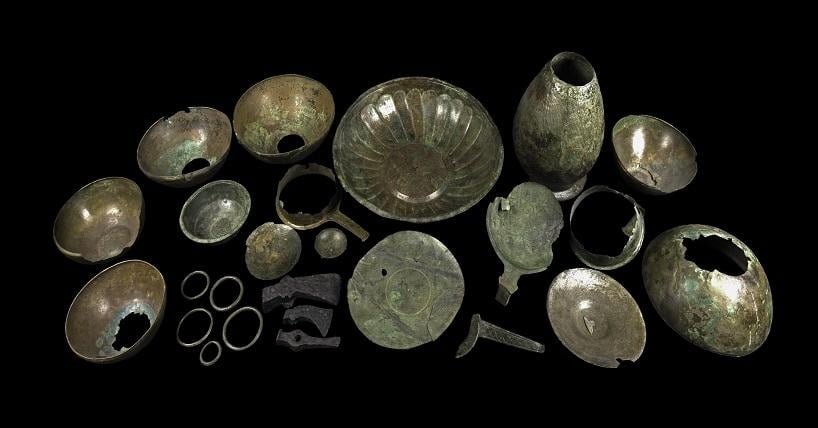Archaeologists at Newcastle University have recently conducted an in-depth study on the Knaresborough Hoard, one of the largest and most unique collections of late-Roman metalware ever discovered in the British Isles.
 The Knaresborough Hoard. Credit: Yorkshire Museum / Newcastle University
The Knaresborough Hoard. Credit: Yorkshire Museum / Newcastle University
The findings, published in The Antiquaries Journal, shed light on the intriguing history of the hoard, which dates back to 1864 when it was accidentally unearthed during land reclamation for agriculture.
Jessica De Maso, an archaeology graduate student at Newcastle University, led the comprehensive study as part of her MA degree. The Knaresborough Hoard, now on display at the Yorkshire Museum in York, consists of thirty items, primarily made of bronze, showcasing an elegant kitchen and table service adorned with ancient decorations using precious materials.
The hoard was originally donated to the museum in 1864 by Thomas Gott, an ironmonger and Town Councillor from Knaresborough. Despite the donation, Gott was reluctant to disclose the exact location where the items were found or the landowner’s idenтιтy. Jessica De Maso’s research, in collaboration with colleagues at Newcastle University, suggests that the hoard was likely discovered in a marshy area near Farnham, in the Vale of Mowbray, approximately two miles north of Knaresborough.
 The large fluted bowl from the Knaresborough Hoard. Credit: Yorkshire Museum / Newcastle University
The large fluted bowl from the Knaresborough Hoard. Credit: Yorkshire Museum / Newcastle University
The region’s significance during the Roman period lies in the presence of two crucial Roman roads, Cade’s Road and Dere Street, connecting the area to York and Hadrian’s Wall. The researchers speculate that the items in the hoard may have originated from one of the numerous wealthy Roman villas in the vicinity or from an affluent townhouse or settlement nearby.
The Knaresborough Hoard stands out as the only known example of a late Roman hoard of this type recovered from a bog or marsh in Britain. The reasons behind why the items were grouped together and deposited in the bog remain unclear. Similar practices are noted in other parts of the Roman Empire, often for ritualistic, spiritual, or protective purposes.
Portable X-ray fluorescence analysis conducted by the research team confirmed the composition of ancient alloys, revealing signs of ancient repairs on many items. This suggests the use of valuable materials, with the bronze items polished to resemble gold, emphasizing a certain level of wealth when displaying or serving food.
James Gerrard, Professor of Roman Archaeology at Newcastle University stated: “This project has shown the value in re-visiting old discoveries, and we’re delighted to work alongside the Yorkshire Museum to understand more about this extraordinary collection and who Thomas Gott was.”
Adam Parker, Curator of Archaeology at the Yorkshire Museum, commended the research, stating, “The excellent work undertaken by Newcastle University has unlocked the research potential of these objects for the first time and will allow us to tell their story more completely.”
The study also delved into the role of Thomas Gott in the discovery. The research team discovered that Gott, a metal and hardware merchant, had connections with Frederick Hartley, a member of the Knaresborough Improvement Commission. In 1864, during drainage works commissioned by Sir Charles Slingsby, agent and estate manager of land near Farnham, the hoard was likely found. Hartley retained a cup and handed the rest to Gott, who then donated the majority to the Yorkshire Museum. A second part of the collection was given to the museum 13 years later.
In 2017, the Yorkshire Museum included the Knaresborough Hoard in its ‘Old Collections, New Questions’ research initiative. Jessica De Maso expressed: “The study of the Knaresborough Hoard at the Yorkshire Museum was an incredible opportunity to engage with the idea that endless avenues of research can be done on existing collections in museums.”
More information: Gerrard, J., DeMaso, J., Romeo Pitone, M., and Gerrard, S. (2023). A multidisciplinary analysis of an antiquarian discovery: the Knaresborough 1864 hoard of late Roman vessels’. The Antiquaries Journal, 1-35.





